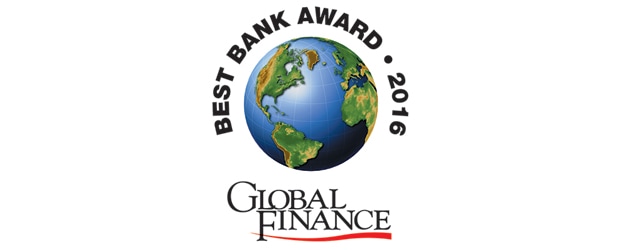Global Finance unveils its annual lists of the best banks in the world, globally, regionally and by country. The winners have outperformed their peers and provide top-notchservice to clients in a challenging environment.

Global Winners |
|
|---|---|
|
Corporate Bank |
BNP Paribas |
|
Consumer Bank |
Royal Bank of Canada |
|
Islamic Financial Institution |
Samba |
|
Emerging Markets Bank |
Industrial and Commercial Bank of China |
|
Frontier Markets Bank |
Qatar National Bank |
|
Global Custodian |
Northern Trust |
|
Subcustody Bank |
Standard Chartered Bank |
|
Investment Bank |
UBS |
|
Equity Derivatives Bank |
Societe Generale |
|
Credit Derivatives Bank |
Citi |
|
Interest-Rate Derivatives Bank |
Societe Generale |
|
Cash Management Bank |
Citi |
|
Trade Finance Bank |
Citi |
|
Supply Chain Finance Bank |
BNP Paribas |
|
Foreign Exchange Bank |
Citi |
Some Banks Fly High Despite Turbulence

Low interest rates, low oil prices and low economic growth rates pose a triple threat to the global financial system, but some banks are performing remarkably well and helping their clients succeed in a world fraught with political unrest and economic uncertainties. In this, our 23rd annual survey, Global Finance selects the best banks in 143 countries and eight regions of the world. We also identify the best global banks in various service categories.
While US banks are raking in record profits, expectations for bank earnings in Europe remain gloomy, according to Fitch Ratings. Prolongation of the low-growth, low-interest-rate environment threatens to tighten the squeeze on bank earnings, hampering capital-raising efforts by some, the rating agency says in a recent report. “EU bank capital is in better shape than before the financial crisis, but nonperforming loans in aggregate remain elevated at three times the rate of US peers,” Fitch says.
Challenged asset quality in Southern Europe, coupled with a high reliance on bank financing rather than capital markets in Europe as a whole, contributes to the economic underperformance of the EU relative to the US, according to Fitch. It says that of the core EU countries, the problem is most acute in Italy, where nonperforming loans have risen to almost 20% of total loans outstanding.
The Asia-Pacific region has accounted for nearly half of global banking profits each year since 2009 but is now facing a powerful storm that could slash bank earnings dramatically in the next five years, according to global consultancy McKinsey, which analyzed 328 banks in the region. The economic slowdown in Asia-Pacific, along with technology disruption to the banking sector and weak balance sheets, could “cripple return on equity” by 2018, McKinsey says. Slower growth in lending and surging loan defaults lifted stressed assets in China, India, Indonesia and Japan to nearly $400 billion last year. The double-digit profit growth posted by banks in the region in the past five years will shrink to about 4% annually in the next five years, McKinsey says.
The increasing volume of nonperforming loans is putting added stress on banks, as interest-coverage ratios, a measure of how easily companies can pay interest expenses, are declining at large companies throughout the region, especially those in China and India, the report says.
“Our analysis indicates that by 2020, banks in Asia need to raise $400 billion to $600 billion in additional capital to cover losses from nonperforming loans while maintaining capital-adequacy ratios,” McKinsey says.
China now has four of the five largest banks in the world, according to S&P Global Market Intelligence’s latest ranking of banks by assets converted to dollars. Many of China’s big state-owned banks already have announced that their profits will continue to be pressured in the second half of 2016, as margins narrow and bad loans increase in a slowing economy.
Meanwhile, conventional banking in Asia is under attack from start-up technology companies offering financial products such as payment systems and lending platforms and by established companies from outside the industry, such as Alibaba and Tencent Holdings, according to the McKinsey report. It advises Asian banks to build up their own digital capabilities quickly. “In surveys, banking customers in Asia-Pacific frequently list limited digital offerings and unsatisfactory service as major sources of frustration,” the report says.
The US banking system appears to be relatively healthy, compared with most other systems around the world. Eight years after the financial crisis, the Federal Deposit Insurance Corporation (FDIC) says US banks’ earnings in the second quarter of 2016 rose 1.4% from a year earlier, to a record $43.6 billion, as growth in lending produced higher interest income, despite low interest rates. Some 60% of banks reported higher earnings, while only 4.5% were unprofitable.
FDIC chairman Martin Gruenberg cautions, however, that US banks are still operating in a challenging environment. The impact of low oil prices on energy companies, for example, has led some banks to post higher losses on commercial and industrial loans. Nonetheless, overall lending in the second quarter grew by 2%, to $181.9 billion, with the largest increases coming in home mortgages, other real estate loans and credit cards.
The number of banks on the FDIC’s problem list fell to 147 from 165 in the first quarter, and was the lowest in eight years. A decline in bank failures has enabled the deposit insurance fund to grow to $77.9 billion as of the end of June.
Banks in Europe also are making a growing number of new loans. The European Central Bank’s July 2016 bank lending survey, covering the second quarter, showed a further net easing of credit standards on loans to businesses in the euro area. Competitive pressure remained the main factor driving this easing, with a narrowing of margins, the ECB says.
Although net demand for loans continued to increase across all loan categories, a rise in mergers and acquisitions was the main contributing factor, followed by loans for inventories and working capital, and demand caused by the low level of interest rates.
With regard to the likely impact of ongoing regulatory or supervisory changes, euro area banks continued to adjust in the first half of 2016 by further strengthening their capital positions and reducing their risk-weighted assets, with the reduction mainly owing to a decline in riskier loans, the ECB says.
Bronka Rzepkowski, lead global strategist at Oxford Economics, says it is still too soon to become optimistic about European banks. In a note to clients, she says expectations for 2016 earnings at euro area banks have taken a turn for the worse, and analysts now expect them to decline by about 20%.
Following the June UK referendum on leaving the EU, Fitch Ratings says, bouts of market volatility refocused investor attention on three key challenges for European banks: profitability, asset quality and capitalization levels.
“The impact of Brexit is expected to be broadly negative for UK banks,” Fitch says. However, it adds that there are no immediate credit-rating implications on banks rated by Fitch, “as they are resilient to a moderate deterioration in the operating environment at current ratings levels.”
In emerging markets, excess capacity is being unwound, especially in commodity-related sectors, through sharp reductions in capital spending, the International Monetary Fund says in its latest global financial stability report. High private debt burdens reinforce risks to sovereign balance sheets, credit markets and banks, the IMF says.
With this survey, Global Finance recognizes the banks that are best placed to help their clients successfully navigate a world in flux. The listing includes the best global corporate bank, the best consumer bank and the best banks worldwide for emerging markets, frontier markets and subcustody services, which are being announced here for the first time, as well as previously announced awards for Islamic finance, global custody, investment banking, cash management, trade finance and foreign exchange.
The winners are not necessarily the biggest but rather the best banks—those with the qualities that corporations and individuals should look for when choosing a bank. These banks offer superior service, the most effective risk management and the best products.
We selected the winners based on performance over the past year, as well as subjective criteria, including reputation and management excellence. Global Finance made the selections after extensive consultations with bankers, corporate financial executives and analysts worldwide.



